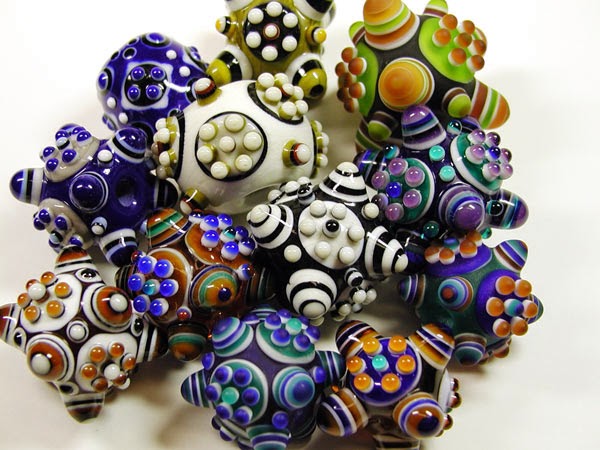Warring States refers to the time in Chinese History just after the Spring and Autumn period (approx. 1045-256 bc), and ending with the beginning of the Qin Period (which begin in 221 bc) which created a unified China. The Warring States refers to the period when many states existed and were fighting to gain control of China. Warring States beads are called that due to the time period in which they were made.
It was thought that China did not produce glass beads because artifacts found were made mostly from metal and ceramic. The glass found was not only produced much later in history than in Egypt , but was also made up of differing chemicals than the typical soda lime glass that was found then and is used today. It was made up of mostly lead and barium oxide.
The warring states beads are characterized as "eye" beads, or "dragonfly eye" beads and consist of mostly dots. Dot patterns are very prevalent in all types of glass beads and can make some very complicated designs!
Initially, the beads were used in high-profile burials, but over time, they became more prevalent and available to a wider range of people, and were found in medium and small burials as well.
Today, one of the best known glass artists to take influence from warring states beads is Larry Brickman. His beads are amazing, and he is a master in the placement of dots. Here are some images from his gallery - he rarely has beads available but he does teach! (I tried getting in touch with Larry Brickman to inform him I was showing his work but my emails were returned).
Another glass bead guru who makes warring states beads is Tom Holland. This is a photo of a bead of his in my personal collection.
There are many other glass bead makers who use warring states beads as influence in their work, and I hope you take some time to do further research if you are interested.
Susan Kennedy










Sadly, I didn't know ANY of this! I've heard of and seen warring states beads, but didn't know the history. Thanks for the education!
ReplyDeleteI knew nothing! thank you for the blog post!!!
ReplyDeleteLove the warring states lampwork beads. Some of my favorites were made by Dustin Tabor - he did amazing work for being a young kid at the time. Then again the Hollands were some of his mentors - he learned from the best. Sadly he went on to a business career. Kudos to those who create these beauties. Thanks for sharing, Sue!
ReplyDeleteThanx for the interesting post. I am always ready to learn more history of beads.
ReplyDeleteWow, Susan! This post was out-of-the-blue-fascinating.
ReplyDeleteLead in glass does not surprise me, I own lead crystal, but BARIUM! Whoa! I think of barium as radiopaque, as in X-ray studies. Barium glass. Eye-opener!
Thank you for this wonderful post!
I had never heard of warring states beads and did enjoy learning a little about them. They are lovely - especially those old ones! Now off to learn more...
ReplyDeleteI learned a bunch from your post today! I had no idea there was so much history behind this type of bead. Thank you for sharing!
ReplyDeleteI love Art History in all shapes and forms. That was a good read, Sue!
ReplyDeleteThank you for taking the time to share with us your research on warring beads. I enjoy and appreciate the wonderful doors you and your fellow artists open for your readers.
ReplyDeleteGreat post, Susan. Though I have long been a student of all things Chinese, I had not heard of these beads. Chinese Art history is full of all kinds of artifacts that still inspire us today.
ReplyDeleteThat was one heck of a lesson! Thank You!
ReplyDeleteThank you all for stopping by!
ReplyDeleteHey - great post! You're actually using a couple of my pictures (you'd find a few more on my Pinterest page -- https://www.pinterest.com/sandabeads/sa-beads-beadstorecom/ -- but I think it's awesome when people share my pictures, so no worries). One of the really fun things about the Warring States beads is that they are just so magically beautiful when you actually see them in person. Once you see a few, you realize just how the fakes pale in comparison in terms of craftsmanship and beauty. Even the good fakes just don't quite capture the majesty. Thanks for the really nice post! Cheers, Abe
ReplyDelete